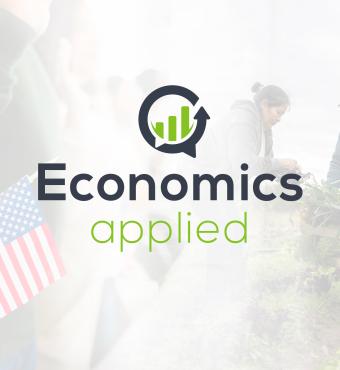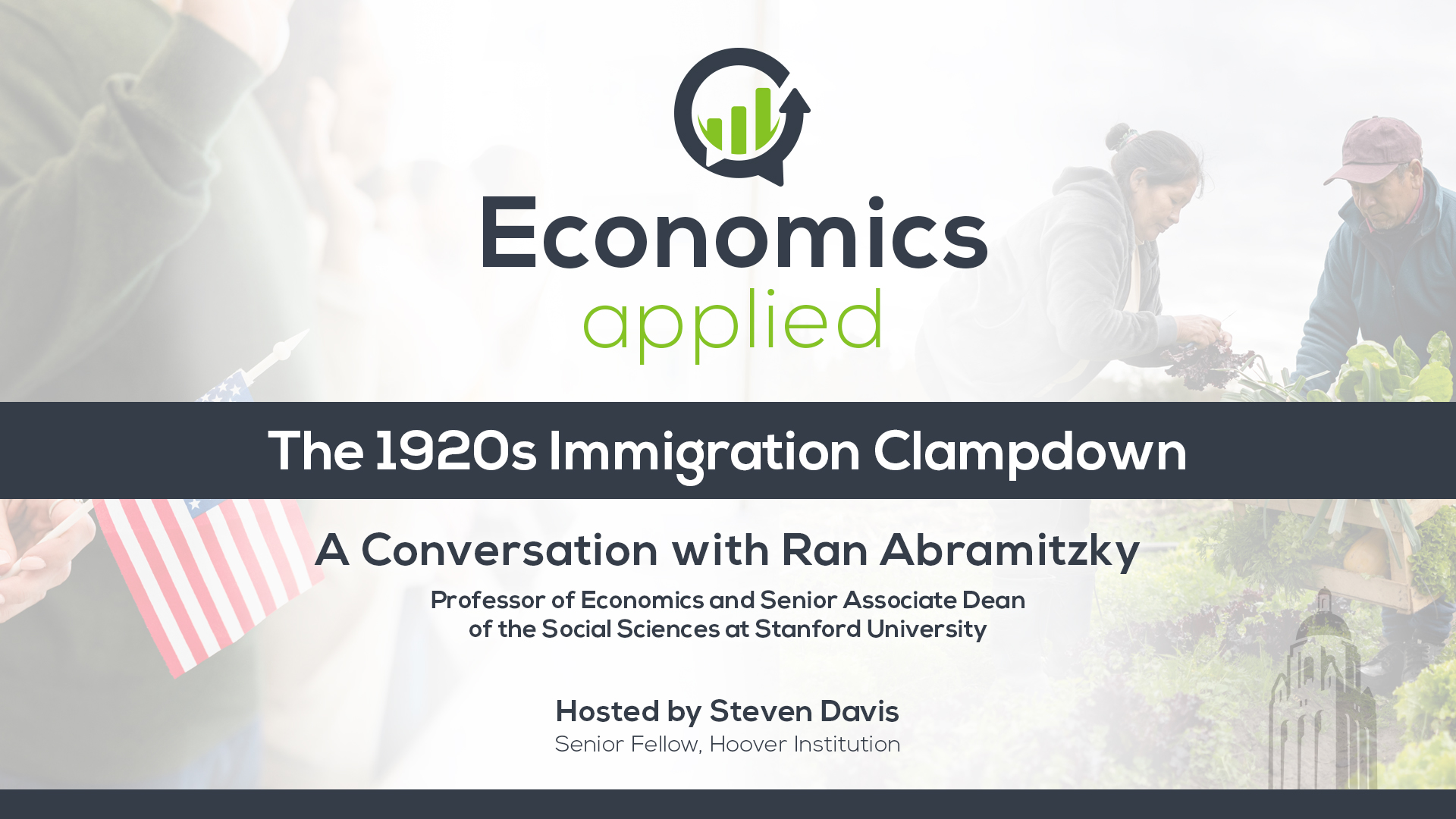- Economics
- Immigration
- Answering Challenges to Advanced Economies
In the 1920s, the US government sharply restricted immigration inflows from countries in Eastern and Southern Europe. At the time, most immigrants from these countries had modest skills. Steve speaks to Stanford economist Ran Abramitzky about these immigration cutbacks, their effects on the earnings of US-born workers, and how the economy adapted.
Recorded on April 2, 2025.
WATCH THE VIDEO
>> Steven Davis: If the US government cuts the immigration of less skilled workers, will the effect be to raise or lower the earnings of US-born workers? That may sound like an easy question with an obvious answer. It's not. So let's look to the historical record. In the 1920s, the US government sharply restricted immigration inflows from countries in Eastern and Southern Europe.
At the time, most immigrants from these countries had modest skill levels. What happened afterwards to the earnings of US-born workers? Stay tuned and find out. Welcome to Economics Applied. I'm Steven Davis, Senior Fellow at the Hoover Institution and host of the show. Our guest today is Ran Abramitzky.
He's a Professor of Economics and Senior Associate Dean of the Social Sciences at Stanford University. He's also a highly accomplished researcher, with outstanding works on immigration and other topics. His most recent book with Leah Boustan is titled Streets of Gold, America's Untold Story of Immigrant Success. Welcome, Ran.
I'm really looking forward to our conversation.
>> Ran Abramitzky: Thank you very much for having me, Steven. And I look forward to it, too.
>> Steven Davis: Okay, before we start, let me note that we are both Senior Fellows at the Stanford Institute for Economic Policy Research. Congrats to CPR for the good judgment to appoint us as fellows.
>> Ran Abramitzky: Yes. I'm telling you, they are doing a terrific job in general. They have been very supportive of my research for many years, and my students. And so I'm very grateful to be a fellow there and be your colleague over there.
>> Steven Davis: Yes, well, and there's good reason for them to support you.
So let's talk about one of them. You, you recently co authored an article. It's a research article, scholarly article, on the immigration restrictions that the United States imposed in the 1920s. As we'll discuss, they were really a major shift in the stance of US Immigration policy. Part of the goal of that paper, as I understand it, was to provide evidence on how these restrictions affected the earnings of US Born workers to get us started, set the stage for us.
What was the prevailing sentiment and political context around immigration and immigration policy in the decades leading up to the 1920s? Tell us, put us in that situation so our listeners will know what happened and why.
>> Ran Abramitzky: So in the late 19th and early 20th century, about 30 million European immigrants entered the United States.
Immigrants often entered through Ellis Island, the borders were nearly open to European immigrants, although they were not open borders. You know, we all know that, you know, the 1882 Chinese Exclusion act was the first law in the United States that excluded members of a specific ethnic group from coming to the United States.
But European immigrants did not require the visa or a passport to enter the U.S. nor did they need to show that they have a job waiting for them or a family member, and so on. And so in the 1850s and 1860s, about 90% of immigrants were from Northern and Western Europe, like, think, British Isles, Germany, Scandinavian countries.
And then Starting in the 1890s, immigrants from Southern and Eastern Europe, like from Italy and Russia started to come in larger numbers, so that by the 1920s, about 40% of the immigrant stock was from southern and Eastern Europe. So then in the 1920s, this period of open borders came to an end with strict country specific quotas that heavily favored immigrants from Northern and Western Europe over immigrants from Southern and Eastern Europe.
The way these quotas were done in practice is the quota act of 1921 assigned entry slots by country of origin and were set to about 3% of the foreign born stock from each nationality living in the United states as of 1910. But then the 1924 Immigration act shifted the base year for measuring the immigration stock to, to 1890 and lowering the inflow from 3% to 2% of that stock per year.
And lawmakers chose 1890 because it was before the mass immigration from southern and eastern Europe started ensuring that the vast majority of immigrants were from northern and western Europe. And as a result, immigration from southern and Eastern Europe fell from about 70% of the total immigrant stock in the early 1900s to about 15% after 1924.
So the, you know, the. Yeah, so we can talk more about, I want to see what.
>> Steven Davis: So, so at the time, and this, this is quite removed from the current situation, Immigrants from Eastern and southern Europe were seen as undesirable, low skilled, not easily assimilated, incompatible, at least by many.
Incompatible, at least in very large numbers with the kind of society that some in the US wanted.
>> Ran Abramitzky: Exactly. In the 1920s immigration restrictions were the outcome of a long process of building a political coalition against immigration. Congress commissioned the Dillingham Commission in 1907 to study immigration. And in 1911 they submitted this 42 volume report that essentially concluded that southern and eastern European immigration was a threat to the United States, and that immigration policy should heavily restrict immigration from these countries.
>> Steven Davis: Okay, so by the way, just note, there's a previous episode of economics applied on the Chinese Exclusion Act of 1882 with Nancy Qian. Great. As you pointed out, that was the first really major restriction on US immigration that largely affected the western United States and had little or no effect on the eastern part of the country, at least directly.
Whereas here, what we're talking about, immigrants who are coming over the Atlantic, crossing the Atlantic, and at least entering initially eastern seaports. Now, you didn't mention anything about immigrants from Canada or Mexico or the Caribbean islands.
>> Ran Abramitzky: Yeah, you know, immigrants, interestingly, in this period, you know, immigrants from Canada and Mexico was not.
Immigration was not restricted from this country. So, you know, it's not to say that it was super easy to get from Mexico. There are stories about how they weren't treated maybe as well in the border crossing, but these countries were not that restricted from entering the United States.
And you will see that this will play part of the story in this paper.
>> Steven Davis: And I think it's also important to understand that it's that especially from the remote, poorer parts of Mexico, as I understand, it was actually very hard to get from Mexico to the United States.
>> Ran Abramitzky: That's right.
>> Steven Davis: You didn't just hop on a bus or a plane. So there were natural barriers to restriction from much of Mexico into the United States that people just took for granted indeed. Okay, so that's the setting. And as you already pointed out, this was a huge reduction in immigration flows from Southern and European countries.
And so this was not a modest change.
>> Ran Abramitzky: No, it was the most dramatic. I would say it was probably the most dramatic immigration restriction in American history. The number of immigrants declined from about a million entrants per year, in the early 1900s to eventually 150,000 per year after the border closed.
>> Steven Davis: Okay. So huge reduction in immigration inflow. So it's not like, you know, one of the great things about economic history is you can find these dramatic policy changes and look to the effects and try to cut through the noise of everything else that's happening in the world, in the economy and so on.
So that's, that's sort of the strategy here, at least in part. There's more to the strategy as, as we'll talk about. Just say a bit more about what the proponents of these restrictive legislation in 1921 and 1924. What they saw as the goals of the legislation, particularly as it might affect wages and jobs of American-born workers or favored immigrant groups.
>> Ran Abramitzky: Yeah, so like today, the contemporary observers and supporters in the early 20th century debated the likely effect of immigration restrictions on US-born workers. And supporters of the immigration restrictions predicted that, you know, higher wages and better job opportunities for the US-born workers once immigrants stop coming, manufacturing firms and farmers were expected to hire the next door US workers, instead of immigrants.
>> Steven Davis: Okay, so in that respect, the, at least in the political discourse around immigration, it's, there's a lot of similarity to then and now.
>> Ran Abramitzky: There are other similarities, you know, that we, it's not in this paper, but you know, other similarities is that, you know, like some of the concerns were economics.
You know, that's what we are going to discuss about today. But some of them are also cultural and social. You know, the, the idea that immigrant groups are not compatible, you know, with U.S. culture and they might not assimilate as well, you know, today, you know, at the time, as you said, it was targeted more towards immigrants from southern and Eastern Europe.
But kind of concerns about the, the makeup of US society was, was a concern as well.
>> Steven Davis: Right. Yeah, so these cultural and economic issues are often intermingled in discussions of immigration, and that's an important point to note. Although, even though our focus today will be on the economic effects, now we're both economists, so I think we know, at least we think we know based on our expertise as economists that the actual effects of immigration are not so straightforward that it might seem obvious that.
Well, if you cut back on immigration, especially low skill immigration, that's gonna have favorable consequences for US-born workers. Explain to us why from an economic perspective it's not so clear, at least as a theoretical matter. What's the sources of complexity there? Why isn't it just straightforward? We have fewer unskilled workers and so wages of American workers will be bid up in the marketplace, especially for the less skilled US born workers.
What's incomplete about that story?
>> Ran Abramitzky: So that logic is very powerful, Stephen, we both know this. You know, this simplistic economic reasoning is.
>> Steven Davis: And by the way, that, that, that logic is part of what's happening.
>> Ran Abramitzky: Yeah, yeah, yeah, for sure.
>> Steven Davis: It's not the full story, so.
>> Ran Abramitzky: Exactly. Yeah, so this simplistic reasoning first, you know, as you said, it's important to know that there is something in it, into it. You know, like the, this is the one usually used by supporters of border restriction is that immigrants, you know, if there are fixed numbers of jobs, you know, the immigrants, immigrant and more immigrants are coming, surely there will be less room for US workers.
And when fewer immigrants are coming, there would be, you know, more jobs opportunities. So the idea that immigrants steal the jobs and reduce the wages of US-born workers. And according to this reasoning, when fewer immigrants workers are coming, employers would have to pay higher wages for US-born workers.
As you said, you know this, this is sometimes part of the story. You know, there are always winners and losers from immigration. You know, if your work is exactly the same as what the immigrants are doing, then you will likely be worse off when immigrants are coming. But as you pointed out, Stephen, you know that there is a deeper economic and more complex economic logic suggests that the reality is just more complex than that.
And employers, for example, didn't necessarily have to pay higher wages. They have other options on their menu. So they could replace European immigrants with US-born workers who move from other areas, for example, or they could replace European immigrants with other immigrant groups from Canada and Mexico, that were less restricted.
They could replace immigrant workers by machines rather than by other workers. Farmers can buy more machines, for example, tractors to make up for some of the immigrant losses. Farmers could shift from more labor-intensive crops to less labor-intensive crops that require fewer workers, and firms could collapse altogether. If it's the case that US-born workers were not willing to work at wages, that firms were willing to pay, given what customers were willing to pay.
So the these, you know, there are many mechanisms of adjustments that can happen when the local economy is affected. And increasing the wages of US-born workers is just one of them.
>> Steven Davis: Right. Okay, so I want to summarize what you said, but also add a couple things. So you said, look, if you cut back on the supply of low skilled immigrant laborers workers, there's many possible adjustments that might happen in the economy with firms and so on.
And so it's not so obvious that the main adjustment will be higher wages for US-born workers. So we'll get into more of that, but there's also some other reasons that you didn't mention. One is that low skill immigrant workers may be complements in the production process to higher skilled domestic workers.
So just to make that concrete, it may be the case that low skilled farm workers are supervised by more skilled US born workers. And if you take away those low skilled immigrant workers in the farm sector, then the farmers may just move away from labor intensive agricultural products.
For example, they may move from things like cereals to which are, as I understand, are kind of labor-intensive, to other types of crops which are less labor-intensive. And that would reduce the job opportunities for the US-born people who had been supervising these immigrant workers. So that's one example.
Second thing is, in some economies, the scale of the workforce is important or certain skills that might be more prevalent among immigrant workers are important for the overall production enterprise. So these other forces can. Can also be in play. I do wanna, I do.
>> Ran Abramitzky: And let me add a few more, you know, like, so you're right, you know, scale economy is one.
Immigrants being complementary to US-born workers is another. It's also, you know, that the number of jobs is not fixed, you know, so for, you know, and immigrants tend to come, you know, you know, very high skilled immigrants, not the focus of our conversation today, actually create potentially jobs for, you know, for the, you know, for US born workers, they are more likely to patent and to start startup companies and even low skilled immigrants, you know, sometimes they do the kind of jobs that American workers are not interested in doing or at least they're not in the wages that, that are offered.
You know, for example, in construction today will be in construction and manufacturing and you know, the restaurant industries and elderly care. And so, and so at some level, you know, low skilled immigrants can create services and goods that would otherwise not exist because the US workers.
>> Steven Davis: All right, just one final point on this part of the conversation.
It's an important, somewhat obvious point perhaps, but it sometimes gets, it often gets overlooked in these discussions, immigrants don't just supply labor, they demand goods and services. So when you bring more immigrants into the economy, that increases the overall demand for goods and services in the economy at well, which tends to raise on average, the demand for all workers.
That's a countervailing effect and it's a pretty basic effect, but we want to keep that in mind too. People eat and consume, they don't just supply labor.
>> Ran Abramitzky: Right, and while we are at it, we can add another one, if you will. In a world, for example, of low fertility rates that we have, for example, immigrants tend to be younger in the workforce.
And so they are kind of like they are doing the kind of works they are the workers in the working age, which in the future might be a little bit more problematic in a world of declining fertility.
>> Steven Davis: Right. So that's a big concern for the present day.
Wasn't much of a concern.
>> Ran Abramitzky: Wasn't much of a concern then we.
>> Steven Davis: Are now talking about the two circumstances are quite different. All right, let's go back to the 1920s. We've laid out the, the basic context, we've explained clearly. I hope that it's not obvious a priori how cutbacks on immigration of less skilled workers would actually affect the wages, the job opportunities of US born workers.
So how in this setting that you've sketched, did you actually go about trying to assess the effects of the immigration quotas, the cutbacks on the wage, on the earnings of US-born workers, what was your basic empirical strategy? It sounds like a hard issue to tackle empirically because many things are going on in the economy at the same time.
How did you approach it?
>> Ran Abramitzky: You would think 100 years have passed, and so, You would think we should be able to figure out, Whether the wages of white US-born workers increased or whether US-born internal immigrants and immigrants from Mexico moved in and took the jobs previously held by Southern and Eastern European immigrants.
But as you said, this is a, this is challenging because, you know, you would think we could look at the wages before versus the wages after the, the immigration restrictions. But you know, the challenge is how, how do you isolate the effects of the immigration restrictions from other economic Trends in the 1920s?
And many things change in the roaring 20s, an era marked by advances in automobiles and aviation, communication, radio, etc. So what we do is we kind of take advantage of a few facts in our empirical strategy. You know, one is, you know, one we already discussed. You know, the quota policy was much more restrictive for immigration from southern and eastern Europe than immigration from north west Europe, which was largely unaffected.
The second is that some cities and rural areas had already a large con, you know, southern and eastern enclaves, while others had mostly older communities of north western European immigrants. And the third is that immigrants tend to settle in areas that already have an existing community from their home country.
So here is kind of one, you know, a way to think about our empirical strategy. So consider two cities in Ohio. Cleveland and Cincinnati, both had the same share of foreign born as of 1900 before the immigration restrictions, with a large contingency of German and Irish immigrants. But unlike Cincinnati, Cleveland also had some poles and Italians and Cincinnati didn't, and so after the quota system was introduced, we would expect that immigrants inflows into Cleveland will be lower relative to Cincinnati.
And so what we do is we compare cities like Cleveland that were strongly affected by the national immigration restrictions to cities like Cincinnati that were not before and after the policy change. So it's so called, you know, difference in differences type of analysis. And the benefit of this approach is that the suit the two cities, you know, arguably experienced many of the same economic trends during the roaring twenties, and yet only Cleveland was affected by the immigration restriction policy.
And so any difference in experience between Cleveland and Cincinnati is more likely to be due to the quota policy. And so what we do is we dig into data on hundreds of cities and small towns like Cleveland and Ohio to try to tease out the effect of the Quota.
>> Steven Davis: Okay, so the key point here is even though the policy, the quota, the quota acts in 1921 and 1924 applied to the entire country, their effects were highly uneven across cities and communities in the country because the pre existing share of immigrants from Southern Europe and Eastern Europe looked very differently across areas of the US Economy.
And as you explained, Polish immigrants tend to go to where other Polish immigrants have already settled, German immigrants tend to go to where German immigrants have previously settled, and so on, so the policy, same policy across the entire United States, but very uneven effects across cities and economic areas.
>> Ran Abramitzky: Exactly, you put it much better than I did.
>> Steven Davis: Well, I don't know about that. But you highlighted one empirical challenge in assessing the effects of the immigration cutbacks, which, which is a central one, and that is many other things are happening in the economy at the same time.
So you're going to make your best effort to control for all the other things that are going on in the economy that are affecting all cities and areas, but also the fact that there may be other things that happen in Cleveland that were different than Cincinnati. So you make a very serious effort in your study to control for these statistically.
And we, we don't have to get into the details. That's for a research seminar. And this is, this is not that. But there is one other big measurement or big, one other big inference challenge that it seems to me that you didn't stress. And it's a pretty basic one, which is we don't actually have good, broad, broadly applicable wage measures or measures of wages or even earnings of people back in.
In the 1920s. So you're gonna have to rely on some more indirect measure and tell us what it is.
>> Ran Abramitzky: Yes, I was about to talk about it when, you know, we, when I, when I talk about the findings. But that's a, that's a great point. You know, income, you know, income was not, cannot be observed in historical data before 1940.
You know, the 1940 census was the first time when, you know, like, you know, like income was asking. So instead we measure, you know, we use measure of the income score is a measure we, you know, of a predicted income measure based on, you know, your occupation and other attributes like your age and state of residence.
And so it is kind of like an income score which is different than income. It's more, a little bit more like an occupational ranking of sort, but it is definitely not capturing the full, you know, the full, you know, like salary. So we do various, you know, we look at various measures of, of income scores or occupational rankings.
But at the end of the day, it's an important caveat to remember that we don't have actual salary data. And so all our results have to be thought like that. And similarly, you know, your first point was also very good one, you know, we are only, you know, one of the reason why we are, you know, we, we are focusing on local labor markets because we don't think we can do such a good job at looking at the effect of the economy because of all the challenges that you, that you mentioned.
And so the reason why, one of the reasons why we focus so much on the local labor markets is because that's kind of our best attempt at trying to at least look at places that are comparable before the, you know, the quotas and kind of try to get it best that, you know, like, make it most likely that the things that are different between them are the quotas.
But that's kind of limiting our ability to say things about the entire economy. And that's why we focus so much on the local labor markets in this paper.
>> Steven Davis: Okay, that makes sense. But so just to summarize, we don't, you don't observe earnings or income directly. What you do observe is someone's occupation and you have some assessment of their experience.
And so you're going to impute essentially an earnings or income value to each person, recognizing that we have other information from external sources about how wages and earnings tends to vary across occupations and with experience in occupations.
>> Ran Abramitzky: Exactly. So exactly. So we try to do our best effort to, to look at not just occupation, but you know, the occupation, the state you live in.
>> Steven Davis: Right.
>> Ran Abramitzky: You know, your age, you know, your immigration, various various that we know predict income and we, and because in 1940 we see both income and all these characteristics, we can kind of get a predicted of how each of these characteristics predict your income and then impute it in other, you know, years in which we don't have income based on either, you know, the 1940, you know, like relationship between income and other attributes.
Or we can do sometimes a better, you know, like if we want to look at a closer period, we can look at the in agricultural Census of 1900 or the Cost of Living Survey of 1901 to kind of get at a measure that is more closely measured relative to the time.
So, you know, there are various ways to go about this. We try to do our best given what we see about you, including your occupation, what your income would be, but recognizing that it's inevitably imperfect and it's not capturing full wage story.
>> Steven Davis: Yeah, right. So this is a, this is my characterization of your approach.
This is a sensible, reasonable approach. It's widely used in economic history when you go back before the 1940 census. And I would say it's the, the best in class approach. But nonetheless and we'll come back to this later, we had to recognize it does, it is an imperfect approach, it's an indirect approach and it does create an additional challenge in drawing out inferences.
>> Ran Abramitzky: Exactly. Plus and I and I don't and I can and I don't and I don't think that it's a second order concern. So here is for example, something we cannot capture that I think could be going on. Imagine within occupation, even in an age and stuff differences in wages between immigrants and us born within occupations by wages.
This is something that we will not be able to capture even with our best attempt. And I don't think it's second order. I think much of this can be going on. And so it's important to, this is an important caveat to remember that this is why, you know, I will try to always use here income score with the understanding, you know, we know what it means.
But if I ever say wages, salaries or incomes, then then we know we should establish now that it's a very imperfect measure that he's probably missing out on the right.
>> Steven Davis: So the careful listener now knows that we aren't going to be able to address the question I posed at the outset with 100% confidence.
>> Ran Abramitzky: Right.
>> Steven Davis: Because we got to rely. But nonetheless, we're going to do the best we can and see what we can learn. Okay, so, but before we get into the meat of your analysis, you did a preliminary analysis, which I think we should put on the table, which is just answering the question, did the immigration quotas, did they actually reduce immigration and did they reduce it a lot in the areas where previously there had been a large enclave of immigrants from the affected countries from southern and eastern Europe?
So before we even get off the ground, we got to know, did this policy actually restrict immigration? And did it do it in an uneven spatial way, as we discussed earlier. So tell us a little bit about that.
>> Ran Abramitzky: Yes, so that's a simple, you know, local labor markets that were more exposed to the national immigration quotas lost more immigrant workers relative to less exposed markets.
That's kind of like a clear. The policy worked.
>> Steven Davis: The policy worked.
>> Ran Abramitzky: They tried to restrict immigration from southern and eastern Europe and they were able to do that. And so places in the United States that had more of those immigrants saw much fewer immigrants in the subsequent years than places that didn't.
>> Steven Davis: Okay, so these border closures actually are closures, so to speak, restrictions. They, they did in fact have big bite.
>> Ran Abramitzky: Yeah.
>> Steven Davis: And, and much more so in local areas that had previously attracted many immigrants from southern and eastern Europe. All right, so then, so then there's something you call the border closure policy puzzle, which I think you regard as one of the central results in your paper.
Tell us about that and how you arrived at this puzzle.
>> Ran Abramitzky: So, so, you know, so again, you would think that such a large policy restriction, you know, would have, you know, still, the simple economic logic is a, is a sound economic logic. You would think that in such a dramatic, you know, like policy restrictions, there would be some effects on, on, on wages or on, on income scores, you know, and, and what we find when analyzing the data is more complex than the simplistic logic that restricting immigration results in higher incomes for US Born workers.
So we find that US Born workers in more exposed labor markets did not benefit from the loss of immigrant workers. And again, caveating this, that we unfortunately don't have income. And he said measure with income score, but they did not have higher income scores as a result of immigrants top-coming.
And so the rest of the paper was then like, well, how come, how, how can it be that. So fewer immigrants are coming, and clearly some places are very affected by this and receive way fewer immigrants. And yet the the the income scores of the US born does not seem to rise much at all, neither in urban areas nor in rural.
>> Steven Davis: All right, so let me stop you here cuz this is where I was not persuaded.
>> Ran Abramitzky: Yeah.
>> Steven Davis: Maybe you can persuade me. So I want to put a different interpretation of your, what you call the, the border. The puzzle.
>> Ran Abramitzky: Yeah.
>> Steven Davis: And again, the puzzle is using these occupation based income and I've been saying earnings scores, you don't actually see a rise in those in the communities that are more heavily impacted by the cutbacks on immigration from eastern and southern Europe.
Here's an alternative interpretation of that. Maybe there's something in your evidence that cast doubt on this interpretation, but I didn't see it. Here's the interpretation. During that time there were many jobs that were typically filled with by less skilled immigrants that had fairly inelastic demands. And I think about things like the butcher, the street sweeper, the laborers made the low skilled construction workers, these kinds of, the guys, the laundry, the laundry shop washing the clothes.
And I'm stressing two things about these. These were often onerous jobs so they were often filled by less skilled immigrants. When you had those folks, they also had pretty inelastic demands for some of these. So somebody's going to fill these jobs if you get rid of the immigrants.
And how's that gonna happen? Well, the wages are going to be bid up enough when there's not less skilled immigrants to attract in the US born workers. That's the only way to attract them is to pay more. And that's going to actually be missed by your occupation score measure because it's not, it's not capturing the variation in wages across different local highly localized areas.
In the earnings per occupation. You're just getting these occupation scores. So it could be in a community that's heavily impacted by these immigration cutbacks that wages, earnings rise in occupations that had previously been dominated by less skilled immigrants that draws in the U.S. born workers also will lead to higher wages in the other traditionally non immigrant sectors just because there's fewer US born workers now to fill those jobs.
So I don't see what in maybe I missed it. I didn't see what in your evidence rules out that interpretation of the patterns you find.
>> Ran Abramitzky: I think you articulate quite well our interpretation of what is going on. You know, you're right again. We go back to the discussion we are missing to the extent that it's the butcher earning higher wages, a butcher, we are going to miss it, but that's kind of, and that will be part of the action that is Ms. we can still capture a little bit and our interpretation of what's going on.
And we didn't talk quite yet about the results, but you know, when we will, you know, this is part of much of our interpretation. You know, like, okay, in the very short run, in the very immediate run, you know, like wages must have risen, you know, like to attract people from other places.
But then, you know, like, rather than going to the, you know, like next door workers in these areas and, and kind of like hire them, they attracted people from other less affected areas. So that at the end the income scores was the, you know, like it was not affected and the labor supply did not, did not change as you would expect if you only had a local interpretation of the.
>> Steven Davis: Okay, well, so now you're getting to an important part of how the economy adapted, which are these internal migration of other groups. But I, I, I would just, my overall reading of your results is when you cut the supply of less skilled immigrants, the US Born workers on average move down the occupational ladder in some traditional sense.
Doesn't mean that their earnings fell. Their earnings may have risen across the board, but somebody's filling certain jobs that had previously been filled by less skilled immigrants and those jobs tend to have lower occupational income scores.
>> Ran Abramitzky: Yeah, but that's the interpretation. And again that's my interpretation.
>> Steven Davis: Okay, that's your interpretation as well.
>> Ran Abramitzky: That's our interpretation of the results, our interpretation of the results is that it's just the mechanism of adjustments was likely like a higher wages in the very short run attracted people from other local areas enough so that at the end the labor supply remained the same and they did not have to pay more wages for these workers.
But again.
>> Steven Davis: Okay, and just to make sure that with my interjections, we didn't lose an important part of the thread. You do find internal migration responses to be an important part of the reaction. So the areas that really lost a lot of less skilled immigrants, those are the ones that had larger inflows from US born workers and from the unrestricted immigration groups.
Am I right?
>> Ran Abramitzky: Yeah, yeah, so I think you almost articulate part of our results, but I don't, I view what you said as really part of our results. I'll say it maybe in, in a, you know, we, so we document kind of two local responses to the immigration quotas.
In urban areas, especially in manufacturing, what we are talking about now was what happened, more affected labor markets attracted new workers likely because they paid higher wages in the very short run, including US-born internal migrants and immigrants who were not restricted by the quotas. And as a result, the net labor supply did not change, and in contrast in rural areas, farmers instead substituted toward capital intensive crops.
So think wheat as opposed to corn and hay. And so the loss of immigrant workers in more affected labor markets in rural places encourage farmers to to invest in more farm capital and shift away from labor intensive crops And then and then the third thing you in the mining sector, which was, has been heavily dependent on new on immigrant workers, that sector contracted altogether after the border closure, so no other and as a result, new workers were not attracted to these areas.
This is kind of more in line of your story of like, you know, well he he was just not worth keep doing. And so like immigrants stopped coming, you know, like the industry just contracted and no other workers came from the outside. The wages were not adjusted and and factor and there was no and no more investment in capital because there wasn't that much capital intensive investment at the time for mining.
And so it was just, just brought the the mining industry to to.
>> Steven Davis: Yeah, so you you, you already jumped into into the mining and farm sector responses which I think are quite important and interesting because they do have application to the present day. So I'll repeat some of what you said in different words and tell me if I have it wrong.
In the farming sector where immigrant unskilled immigrants had played a large role when the supply was cut back, many farmers said and it was partly because of the technological advances that had been happening, you know what, we should just mechanize. More of our farming activity. And when we can't, when we can't really mechanize effectively, we're just going to get out of those crops.
And those crops were no longer as, as, you know, as abundant in the United States. Something very much like that could happen in the United States. And it has happened at various times. Whereas you cut off the supply of, in this case, Mexican immigrants, low skilled Mexican immigrants.
Well, one possibility is US Farmers will mechanize because it's just too expensive to pay American workers. Another.
>> Ran Abramitzky: There is some evidence for this, by the way, later on in the Brazil program. There's a nice.
>> Steven Davis: Yes, this is why I bring it up. This isn't just something that happened in the 1920s.
This is a very relevant margin for the US agricultural sector. Now mechanizing or just getting out of that crop entirely. And then, then those, the kind of farm produce that came from certain crops will just be imported or they, less of them will be consumed because they'll, they're too expensive.
And similarly, for the mining one's interesting because industries don't always survive these kind of, from their perspective in mining, this was a cost shock. All of a sudden, cheap labor wasn't available. Many mines that had been economically viable beforehand were no longer economically viable and so went out of business.
So I, it's important to recognize that these margins can also be in play. And in the 1920s, in the farm sector and in the mining sector, apparently they were.
>> Ran Abramitzky: That's right.
>> Steven Davis: Okay, so you, do you want to say anything more about differences between urban and rural sectors?
In the manufacturing sector, you had, in the manufacturing sector, you, I think you had a little bit more evidence you could bring to bear. Do you want to add anything to the discussion on that front?
>> Ran Abramitzky: Yeah, maybe I'll say in some part of the paper we look beyond the censuses.
We look at the kind of censuses of manufacturing and mining and agriculture and manufacturing did not have a net decline in labor supply after the quarter policies as we discussed, as workers move in from other areas. And indeed we find no evidence for changes to the capital labor ratio.
For, example, in manufacturing, we measure it as horsepower per manufacturing workers. And we also find that, you know, like the, like in the same sector, we find that in the mining and the rural areas lost workers from major industries and the two industry, like, and that the two industries again responded very differently, the mining and the farmers.
So in the agricultural sector responded to the lost of farm labor by shifting into capital intensive production. So we find that the, the agricultural sector in rural areas with more quota exposure was more likely to plant capital intensive wheat again, as opposed to corn and hay. And we do not have data on tractor usage, for example.
That would have been very nice.
>> Steven Davis: Yeah.
>> Ran Abramitzky: But we do find an effect of the quota restrictions on the use of draft animals, like horses and mules. And in contrast, as we discussed, the mining sector contracted and we find that they reduce the capital expenditure and the output.
We find suggestive evidence that the number of mines contracted after the border closure in states that had greater exposure to the quota policy. And as the industry contracted and the number of workers decline, we see capital per worker also fell. And the fact that the mining industry did not substitute into more capital intensive forms of production as it lost immigrants is consistent with the lack of substitutable capital or available mechanization in the mining industry.
So unlike the tractors that were invented in the twenties, much of the, of the technology that would allow them to mechanize, only was only invented later.
>> Steven Davis: Okay, there's a lot, there's some subtlety there.
>> Ran Abramitzky: Yeah.
>> Steven Davis: Which I'll summarize in the following way. The ability to substitute away from less skilled labor to kind of technologies that are more capital intensive, they can be important in some times and places, but the availability of those opportunities changes a lot through time.
So your story is there was a new technology, technology available in the farming sector, tractors which could replace horses and mules, and farmers did take to that. Once less skilled labor became more expensive in the mining sector. At the time, the ability to make that substitution was really limited.
So instead, mines just went out of business. Indeed, in the present day, you know, we, we think about the manufacturing sector and it's become highly automated. Manufacturing share of employment's been declining around the world, not just in the United States, for decades. So that ability to substitute towards more automation in the manufacturing sector seems quite relevant for thinking about what might happen from immigration restrictions or tariffs for that matter.
By the way, I say we're taping this. I can't resist noting just shortly before President Trump will tell us we're all liberated by tariffs. His motivation is that, at least in part, is that we're going to bring back manufacturing jobs to the United States. But this is a digression, but we got to think about, well, what else might happen because we could just automate manufacturing more or instead of bring back manufacturing jobs to the United States, and in your setting, we saw that this kind of substitution response happened in some sectors like farming, but not much in other sectors like mining.
Now, I wanted to ask you about one other thing which, as I understand, and correct me if I'm wrong, from your study, did not happen. We did not see large influxes of women into the labor force in the areas that were most heavily impacted by the cutbacks in less skilled immigration.
Is that right?
>> Ran Abramitzky: Yeah, that's right. We thought one possible margin of economic adjustment to the loss of immigrant workers could be the entry of women into the labor force. But we find no evidence for this. So we find no association between quota exposure and the share of women in the labor force in any area.
And that's kind of interesting. I think will be nice to have more research on this. I don't, like I did, I was surprised by this finding.
>> Steven Davis: Well, that is interesting and it's a big contrast to what happened during World War II in the United States where there was both a reduction in the labor supply of men because many of them were in the military at the time in the United States, and a huge demand for the production of manufactured goods to support the war effort.
And that did draw many women out of the household sector, so to speak, home production activities into manufacturing activities. That's kind of well known iconic images of Ruby the welder and so on, symbolizing that transition. It did not happen. According to your analysis, after the 1920s, immigration restrictions.
>> Ran Abramitzky: Yeah. Remember though, we are trying here to really narrow. Yeah. To narrow down on the local differences due to the restrictions. It's possible that the war did create this. For example, there is an interesting paper on France after the war, you know, that you can see also the same story that you say about women, you know, entering the labor force after the war.
You know, it's possible that, you know, at larger, the large this actually happened in the economy, but just when trying to isolate it, how much of it was due to the immigrants, you know, it's just not, not there.
>> Steven Davis: Yeah, well, I suspect, I mean this is just a conjecture on my part, but I suspect that part of the reason there was less substitution of women into employment in response to the immigration cutbacks is the technology for time savings in running the household labor was much less advanced in the 1920s than it had become by the 1940s.
And so there was a lot of work to run a household with many kids in the household and many mouths to feed and somebody had to do the work. And it just became much easier to substitute away from say a woman or it didn't have to be a woman, but it typically was performing that kind of household work.
It was easier to make that substitution, that switch in the 1940s than it was in the 1920s. I suspect that's part of the story as well.
>> Ran Abramitzky: Yep.
>> Steven Davis: They'll tell me about it. So, you know, just looking back, we've done a little bit of this already, but I want to give you an opportunity.
Looking back on this historical experience. What lessons would you like to draw for contemporary discussions and debates around immigration policy in the US and maybe, maybe elsewhere as well.
>> Ran Abramitzky: Steven, I would be reluctant to make direct policy recommendations for today based on this particular study. You know, we can't infer from this episode what would happen today.
We discussed a number of things that are different between the past and today. But, but I think we can use this episode. The way I think about this paper is we can use this episode to think about how economies adjust and think through unintended consequences of policies. So, you know, we do, we find it in both cities and rural areas.
Even the most sweeping immigration restriction in American history had only mixed effects on, on the US on the US Born workforce. And you know, some US born workers were able to, to find better jobs. You know, particularly young men from farms were able to move to cities and work in the factories and they were truly better off.
But the benefits for US born workers were far smaller than one might think, because employers are highly adaptive. So when immigrants stop coming, the employers don't necessarily turn to the worker next door and offer them higher, higher wages. Instead they, you know, they search for other pools of labor or they buy new machines.
And so today, you know, the types of jobs might have changed, you know, but, but employers similarly have options to substitute for immigrant workers. As fewer immigrants are coming, they, they can outsource, they can automate, they can invest in robotics. There are various things, it's not that the only option on their menu is pay higher wages for the next door walker.
And the immigration restriction of the 1920s teach us that the idea of closing the borders to help American workers may be too simplistic given the complexity of the economy. Perhaps that's the one lesson I want to draw from this.
>> Steven Davis: Yeah, that's well said and I agree with all that.
I think the other thing I would add to what you said that comes out of your studies, that it's not just that there's all these margins, it's complex to figure out, but the likely way that the economy adjusts to an immigration cutback may differ across sectors. I mean, you drew out the differences between manufacturing, the farm sector, and mining, and to some extent the urban versus rural responses.
So your paper doesn't tell a story of the same thing happened across the board in all these industry sectors and in urban versus rural parts of the country. It was really kind of a complex differential set of responses. And that response depended on the technologies and the workers that were available at the time.
And it's really hard to figure out in advance how that type of thing will play out.
>> Ran Abramitzky: Yeah, and interestingly, we focused here on this paper, which is a historical area, in some of our other works we do have past, present comparisons in economic integration and in intergenerational mobility and in cultural assimilation and various stuff.
And, and you know, one interesting thing is that in some of the other things we look at, you know, despite of the many changes that happen between the past and present, we do find that in some dimensions, like not much have changed in terms of the, of how mobile immigrants were and how much they integrate and the trade offs that they are facing and the sacrif that they make.
And so, so it's a, in this particular study, you know, we couldn't, you know, like, I think there are, you know, too many other things that might be different between today and the past. And you know, like, but, you know, we are thinking now about like looking at other episodes, you know, the 1965 or reopening of the Boulder.
You know, like, we, I, we have great colleagues here at Stanford who worked on, you know, like the, the how the initial building of the wall, you know, like, affected the local economy. This was Melanie Morten. We have Ana Minian that talked about the unintended consequence of immigration from Mexico.
There is a paper we mentioned about, by Clemens and Hannah Postel and others about the Bracero program. So, you know, I think it's kind of like each, each episode will have its, will have its own lesson. But I think that one thing that I can, you know, if I can, if I read the literature and I see the takeaways, is that it's, it's never as simple as, as, as the simplistic logic suggests.
You know, like, it's a very powerful logic. You bring fewer immigrants, things get dramatically better for the US workers. But it's a bit more complicated than that. Many of the topics that we discuss.
>> Steven Davis: We live in a complex and interesting world, makes lots of interesting research questions for people like you and me, but also suggests that we should apply a note of caution to the formulation and implementation of public policies.
All right, thanks so much, Ron. It's been. Ron, it's been a great conversation, really enjoyed it. Keep up the good work and good luck with your multiple hats.
>> Ran Abramitzky: It's been a pleasure, Steven.
>> Steven Davis: Take care.
>> Ran Abramitzky: Thank you for having me.
ABOUT THE SPEAKERS:
Ran Abramitzky is the Stanford Federal Credit Union Professor of Economics, Senior Associate Dean of the Social Sciences at Stanford University, and Senior Fellow at the Stanford Institute for Economic Policy Research. His studies economic history, with a focus on immigration and income inequality. His recent book with Leah Boustan, Streets of Gold: America's Untold Story of Immigrant Success (PublicAffairs 2022), was listed on The New Yorker's Best Books of 2022, Forbes' Best Business Books of 2022, and Behavioral Scientist's Notable Books of 2022.
Steven Davis is the Thomas W. and Susan B. Ford Senior Fellow and Director of Research at the Hoover Institution, and Senior Fellow at the Stanford Institute for Economic Policy Research (SIEPR). He is a research associate of the NBER, IZA research fellow, elected fellow of the Society of Labor Economists, and consultant to the Federal Reserve Bank of Atlanta. He co-founded the Economic Policy Uncertainty project, the U.S. Survey of Working Arrangements and Attitudes, the Global Survey of Working Arrangements, the Survey of Business Uncertainty, and the Stock Market Jumps project. He also co-organizes the Asian Monetary Policy Forum, held annually in Singapore. Before joining Hoover, Davis was on the faculty at the University of Chicago Booth School of Business, serving as both distinguished service professor and deputy dean of the faculty.
RELATED SOURCES:
- The Effect of Immigrtion Restrictions on Local labor Markets: Lessons from the 1920s Border Closure by Ran Abramitzky, Philipp Ager, Leah Boustan, Elior Cohen and Casper W. Hansen, 2023.
- Streets of Gold: Immigration and the American Dream Over Two Centuries by Ran Abramitzky and Leah Boustan, 2022.
- The Long-run Impact of the Chinese Exclusion Act by Joe Long, Carlo Medici, Nancy Qian and Marco Tabellini, 2024.
- The Chinese Exclusion Act and Economic Development, Economics, Applied Podcast, 2025.
FOLLOW OUR GUEST ON SOCIAL MEDIA:
- Check out Ran Abramitzky's website: Ran Abramitzky


















